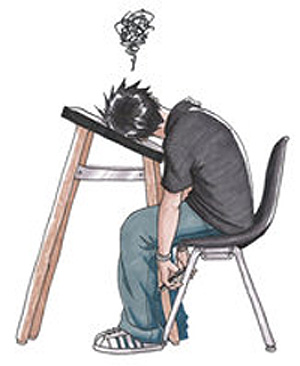How do artists and writers overcome creative block? Is it even real? Yes, absolutely! Without a doubt. I’m willing to bet that creative types the world over have experienced this ultimate form of frustration and aggravation. Artists, choreographers, musicians, sculptors, writers…heck, maybe even scrapbookers! There are days when my muse seems to be on an extended coffee break and she has left in her absence a head full of cotton and cobwebs. It seems that I have experienced this dreaded block far more than my fair share and I wish my muse would give me advanced notice when she’s going on vacation so I could plan around it. It is frustrating to say the least. You sit there at your desk, or easel, or wherever else you create…and nothing happens.
Nothing…happens.
You get up, go put on a fresh pot of coffee, have a snack, come back with your fresh cup of joe, and…you still got nothing. Instead of tearing your hair out, you opt to check your email instead, perhaps even pay some bills. Then you decide that your work area could use a little tidying up. Then you decide you could use more pencils or cadmium red paint. And off you go to the art store, which takes up another hour (or two, because you know you’ll have to browse around a bit). That evolves into another hour at the gym after you return to get your blood pumping and hopefully those creative juices. Sometimes that works. Often times it doesn’t. But what does happen is that you’ve lost huge chunks of time to this wall of nothing in your otherwise creative mind.
But just what is it and how do you overcome creative block?
Is it all in your head as some proclaim? Is it just you being lazy or procrastinating? Or is it a really a legitimate phenomenon that plagues artists and writers alike? First of all, let’s address what creative block is. As defined by Merriam-Webster, it is “the problem of not being able to think of something to write about or not being able to finish writing a story, poem, etc.” or “a psychological inhibition preventing a writer from proceeding with a piece.” The same would then hold true for artists and other creative types regardless of their area of expertise. It’s a problem of not being able to create. The creative well inexplicably goes dry. Some have said that the block is a load of crap. I’ve even heard artists and writers say that. Well unless you’ve been caught in the middle of it, then perhaps for you lucky folks with a bottomless pit of ideas, that’s true. And you are indeed lucky, you with your well of overflowing creativity! But for others of us that have experienced it, it is very real and it is the stuff of nightmares.
“Sure, writer’s block is real. It’s as real as any kind of anxiety,” says poet and essayist Julia Spicher Kasdorf, director of Penn State’s Master of Fine Arts program in creative writing. Stress, anxiety, pressure of looming deadlines, pressure to top the last brilliant work you did can all lead to this creative block. For some, staring at a blank paper or blank computer screen seems to make the mind go just as blank. For artists, it’s that new canvas or the big, brand new block of clay.
It seems the more you try to force the issue, the more creativity eludes you and the bigger the monster gets.
So just how do you tackle the problem of the creative block? Well, it seems if you ask a dozen people, they’ll have a dozen different answers for you. There isn’t just one solution. Here are a few of the more popular ones:
- Create something else. Maybe you have another in-progress project that you can work on for awhile. If not, you can Google writing prompts (for writers) or Google creative prompts (for artists). I happen to like Art Prompts. Maya Angelou once said about her battles with the creative block, “What I try to do is write. I may write for two weeks ‘the cat sat on the mat, that is that, not a rat.’ And it might be just the most boring and awful stuff. But I try. When I’m writing, I write. And then it’s as if the muse is convinced that I’m serious and says, ‘Okay. Okay. I’ll come.” In the case of artists, just doodle. Whether with pen, or pencil, or brush, just get your hand moving across your canvas of choice. It doesn’t have to be a masterpiece, but it is still creating and it may help to loosen things up.
- Stop. Instead of forcing the issue, go do something else. Go for a walk or a workout. Getting your blood flowing may jog your creativity (no pun intended). Go take a shower. A lot of creative thinking happens for some in this otherwise mundane activity.
- Change of scenery. For writers and graphic artists with their laptops, this can be an easy fix. Instead of your desk at home, try the local coffee shop or library. Some painters might have those nifty little travel easels that would allow them to take their show on the road.
- Watch or read something either related to or completely outside the scope of your project. There are a gazillion blogs, articles, newsletters, YouTube videos, or books you can choose from. From personal experience, I will often have a documentary about artists (doesn’t matter what type), or a “makings of” bonus DVD from a movie like Lord of the Rings, or shorter videos found on YouTube about artists (even their how-to videos) on my second monitor while I work. I am inspired by other artists, but can’t always find the time to be around them. This digital method works and often gives me new ideas!
- Good old fashioned brainstorming. There are several methods to this tactic and they can apply to writers and artists alike. This is especially effective if you already have a general idea about your main topic or subject matter, but don’t know where to go from there. Some of these methods include creating an outline, listing ideas in bullet fashion, or cluster-mapping. If you don’t have a general idea and are starting completely from scratch, perhaps combining Art Prompts (or a similar writing prompt generator) with cluster-mapping might work. Also, consider not throwing your cluster maps or bulleted lists away. Those could be used later for ideas!
- Keep an idea journal. This can be a physical pocket-size notebook or a phone app. We are constantly bombarded every day with endless chatter, advertisements, and other visual stimulation. Random people walking down the street can stir up thoughts or ideas. You might hear something that triggers an idea on the radio while driving (obviously, wait until you come to a stop to write it down). Artists, you might come across an interesting pattern or image that you can sketch out for later reference. Do this every time you come across an interesting idea and soon you will have a pretty decent bank of creative stuff to pull from the next time you have a creative block.
So, while I may not believe in the tooth fairy, I most certainly believe that the creative block is real.
Whatever this phenomenon is that is so elusive that psychologists cannot clinically diagnose this malady, it is very real to some of us. Hopefully these tips help you sidestep the next time your muse goes on vacation and leaves the creative block in her place. In the meantime, I’d like to end this post by leaving you with this video of Elizabeth Gilbert, author of Eat, Pray, Love discussing creative blocks and genius through another perspective that will hopefully alleviate some of the pressure and anxiety experienced by artists and writers. Enjoy!
This blog contains Amazon Affiliate links. As an Amazon Associate, I may earn from qualifying purchases.



Recent Comments